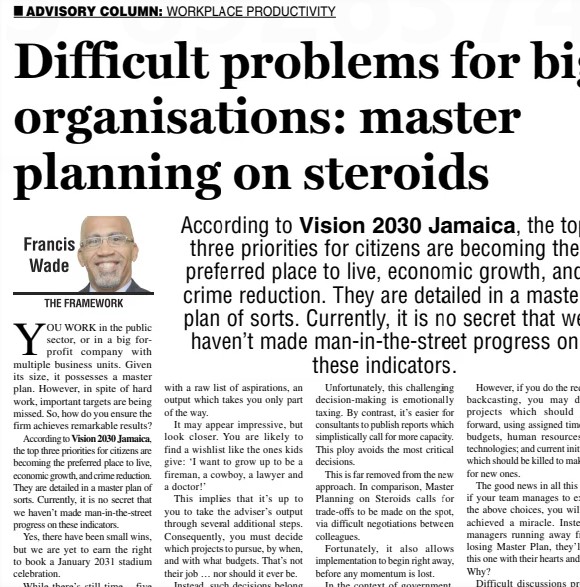If you’re part of a large public-sector organization or a multi-divisional private company, you probably operate within a framework of a “master plan.” This overarching strategy is meant to guide your organization towards its long-term objectives. Yet, despite the hard work, key milestones and targets may still be missed. How can you ensure that your organization achieves significant, measurable results?
In the case of Jamaica’s Vision 2030, the top priorities are clear: establishing Jamaica as a preferred place to live, driving economic growth, and reducing crime. These priorities are fundamental components of Jamaica’s strategic vision. But despite progress in some areas, many still feel that these indicators have not improved significantly at the ground level.
There’s still time to make headway, but achieving these goals before 2031 begins requires overcoming fundamental obstacles. These objectives are ambitious because they necessitate collaboration across various Ministries, Departments, and Agencies (MDAs), each of which was structured during a time when objectives were simpler and more siloed. Bridging these organizational gaps is challenging, but a new approach to master planning offers a pathway forward.
Master Planning in a New Context
The concept of “master planning” dates back to urban development projects of the 1950s, where the goal was to unite stakeholders from diverse fields to create a shared, long-term vision. This vision might span 10, 20, or even 50 years. Once the overarching vision was clear, cross-functional teams could then develop actionable plans—short, mid, and long-term projects that would turn vision into reality.
In recent years, however, master planning has evolved, often influenced by external consultants. These outsiders offer a streamlined approach, claiming that their expertise and global experience can produce superior plans. In practice, consultants often interview key stakeholders, gather perspectives, and compile these into a comprehensive document. While the final report may appear impressive, it often amounts to little more than a wishlist, lacking the practical decisions and prioritization needed to move from strategy to execution.
This brings us to a crucial insight: effective master planning cannot be outsourced. Instead, it must come from within, led by the organization’s own top leadership. Consultants can provide guidance and support, but the real work—deciding which projects to pursue, setting timelines, and allocating budgets—must be done by those who are most committed to the organization’s success.
Master Planning on Steroids: A Bold New Approach
Dwight D. Eisenhower famously said, “Plans are nothing; planning is everything.” The real power of master planning lies not in the document itself, but in the process of bringing leaders together to make tough decisions. This is the core of what we might call “Master Planning on Steroids.”
This approach is not about generating a long list of aspirational goals. Instead, it requires assembling the organization’s top leaders, putting them in a room with the data, and challenging them to make hard choices together. Rather than outsourcing difficult decisions to consultants, the organization’s key stakeholders must confront these choices head-on, weighing priorities and making the necessary trade-offs.
The reality is that this kind of intense, collaborative planning can be emotionally and mentally taxing. However, it’s essential. Consultants might create polished reports with recommendations for “more capacity” or “enhanced resources,” but these generalized solutions often sidestep the most crucial decisions. In contrast, Master Planning on Steroids forces leaders to reach consensus on specific projects, resources, and timelines.
An important advantage of this approach is its immediate applicability. Because the leaders are already aligned on priorities and resources, implementation can begin as soon as the plan is finalized. This prevents the usual delays associated with lengthy approval processes and keeps momentum alive.
Implementing a Master Plan with Staying Power
In the public sector, maintaining momentum on strategic initiatives can be particularly challenging. Political changes, reorganization within ministries, or disruptions like pandemics can derail even the most well-laid plans. Therefore, Master Planning on Steroids is as much about change management as it is about strategy.
For example, a comprehensive strategy to reduce crime in Jamaica would require collaboration across several ministries, including National Security, Education, and Social Security. By using a backcasting approach—starting with the desired future outcomes and working backward to the present—leaders can outline clear, actionable projects with defined timelines, budgets, and resource allocations. This approach also includes identifying existing initiatives that may need to be discontinued to make room for higher-priority projects.
Achieving buy-in from all stakeholders is critical. When leaders are involved in the decision-making process, they are more likely to be committed to the plan’s success. Difficult, face-to-face discussions among peers foster a sense of ownership that cannot be created through an outsourced report. This ownership is crucial for ensuring that leaders do not just implement the plan, but champion it.
Creating a Culture of Accountability
Another key outcome of Master Planning on Steroids is the establishment of a culture of accountability. When leaders are deeply involved in setting priorities and making trade-offs, they are more likely to feel personally responsible for the plan’s success. This sense of responsibility drives them to monitor progress closely and make adjustments as needed, ensuring that the plan remains relevant and effective even as circumstances change.
In the end, a Master Plan on Steroids may not be bigger in terms of aspirations. Its strength lies in its grounded, actionable nature, which is far more likely to yield tangible results. Leaders who engage in this process are not just following a blueprint—they are creating a path forward that they are fully committed to pursuing.
A Roadmap to Remarkable Results
For any large organization, especially in the public sector, achieving breakthrough results requires more than a list of goals. It demands a disciplined, hands-on approach that prioritizes collaboration, accountability, and adaptability. Master Planning on Steroids provides this framework, turning strategy into action and vision into reality.

